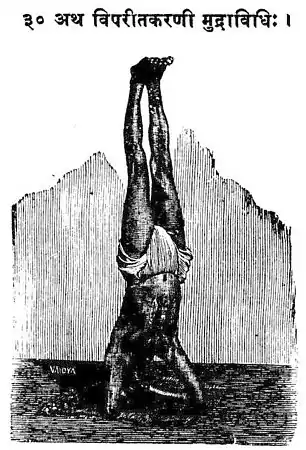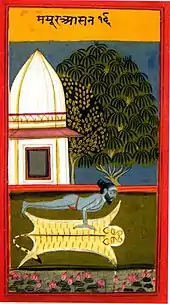Shirshasana (Sanskrit: शीर्षासन, IAST: śīrṣāsana) Salamba Shirshasana, or Yoga Headstand is an inverted asana in modern yoga as exercise; it was described as both an asana and a mudra in classical hatha yoga, under different names. It has been called the king of all asanas. Its many variations can be combined into Mandalasana, in which the legs are progressively swept from one variation to the next in a full circle around the body.
Etymology and origins
The name Salamba Shirshasana comes from the Sanskrit words सालम्ब Sālamba meaning "supported", शीर्ष, Śīrṣa meaning "head",[1] and आसन, Āsana meaning "posture" or "seat".[2]
The name Śīrṣāsana is relatively recent; the pose itself is much older, but had other names and purposes. Like other inversions, it was practised as Viparita Karani, described as a mudra in the 15th century Hatha Yoga Pradipika and other classical texts on haṭha yoga.[3] Viparita Karani, "the Inverter", holds the head down and the feet up for hours at a time, so as to cause gravity to retain the prana. The practice is claimed by the Dattatreya Yoga Shastra to destroy all diseases. to increase the digestive fire, and to banish signs of ageing.[4] The pose is described and illustrated in halftone as Viparita Karani in the 1905 Yogasopana purvacatusca.[5]
Hemacandra's 11th century Yogaśāstra names it Duryodhanāsana ("Duryodhana's pose") or Kapālīkarana ("head technique"),[6] while the 18th century Joga Pradīpikā calls it Kapālī āsana, head posture; it is number 17 of the set of 84 asanas described and illustrated there.[7] However, the 19th century Sritattvanidhi uses the name Śīrṣāsana as well as Kapālāsana, while the Malla Purana, a 13th-century manual for wrestlers, names but does not describe 18 asanas including Śīrṣāsana.[8]
_from_Jogapradipika_1830.jpg.webp) Headstand (labelled Kapālī Āsana) in Joga Pradīpikā, 1830[7]
Headstand (labelled Kapālī Āsana) in Joga Pradīpikā, 1830[7] The mudra Viparita Karani using a headstand in Yogasopana Purvacatuska, 1905
The mudra Viparita Karani using a headstand in Yogasopana Purvacatuska, 1905
Description
In the Supported Headstand (Salamba Shirshasana), the body is completely inverted, and held upright supported by the forearms and the crown of the head.[9] In his Light on Yoga, B. K. S. Iyengar uses a forearm support, with the fingers interlocked around the head, for the basic posture Shirshasana I and its variations; he demonstrates a Western-style tripod headstand, the palms of the hands on the ground with raised elbows, for Shirshasana II and III; and other supports for further variants. Iyengar names and illustrates ten variants in all, as well as several preparatory and transitional poses.[10]
The yoga headstand is nicknamed "king" of all the asanas.[11][12] A variety of other asanas can be used to build the required upper body strength and balance.[13]
Shirshasana, alongside Sarvangasana and Padmasana, is one of the asanas most often reported as the cause of an injury.[14][15]
Variations
.jpg.webp)
Shirshasana permits many variations, including:
| Transliteration | English | Image |
|---|---|---|
| Salamba Shirshasana 2 | Headstand 2 (palms down, shoulder width) | |
| Salamba Shirshasana 3 | Headstand 3 (palms down, in front of face) | |
| Baddha Hasta Shirshasana | Bound Hands Headstand | |
| Baddha Konasana Shirshasana | Bound Angle Pose in Headstand | |
| Dvi Pada Viparita Dandasana | Headstand Backbend | [16] |
| Eka Pada Shirshasana[lower-alpha 1] | Single Leg Headstand | |
| Mukta Hasta Shirshasana | Free Hands Headstand | |
| Parivrttaikapada Shirshasana | Single Leg Revolved Headstand | |
| Parshva Shirshasana | Side Headstand | |
| Parshvaikapada Shirshasana | Single Leg Headstand | |
| Upavistha Konasana Shirshasana | Seated Angle Pose in Headstand | |
| Urdhva Padmasana in Shirshasana | Upward Lotus in Headstand |
Mandalasana, Circle pose, is not a single variation but a sequence of movements in Shirshasana in which the legs move in a full circle around the body from one of these headstand variations to the next.[17][18]
See also
Notes
- ↑ This name is used in Light on Yoga for two unrelated asanas, namely this variant of headstand, and for a one-leg-behind-neck sitting pose, an advanced preparatory pose for Dvi Pada Sirsasana with both legs behind the neck.
References
- ↑ "Shirshasana A - AshtangaYoga.info". Archived from the original on 6 May 2011. Retrieved 11 April 2011.
- ↑ Sinha, S. C. (1 June 1996). Dictionary of Philosophy. Anmol Publications. p. 18. ISBN 978-81-7041-293-9.
- ↑ Hatha Yoga Pradipika III.7
- ↑ Mallinson & Singleton 2017, p. 242.
- ↑ Ghamande, Narayana (1905). Yogasopana Purvacatusca (1st ed.). Bombay: Janardan Mahadev Gurjar, Niranayasagar Press. p. 81.
- ↑ Mallinson & Singleton 2017, p. 104.
- 1 2 Bühnemann 2007, pp. 47, 151
- ↑ Sjoman 1999, pp. 56–57, plate 6 (asana 31) and note 89, page 67.
- ↑ "Supported Headstand". Yoga Journal. Retrieved 11 April 2011.
- ↑ Iyengar 1991, pp. 179–203.
- ↑ Iyengar 1991, p. 127.
- ↑ Among the sources making this claim are:
- Iyengar, Geeta (1 June 1998). Yoga: A Gem for Women. Allied Publishers. p. 187. ISBN 978-81-7023-715-0.
- Hoare, Sophy (1977). Yoga. Macdonald Educational. p. 78. ISBN 978-0-356-06012-5.
- Ramdev, Swami (1 March 2006). Yoga: Its Philosophy & Practice. Diamond Pocket Books. p. 92. ISBN 978-81-89235-15-4.
- Norberg, Ulrica; Lundberg, Andreas (8 April 2008). Hatha Yoga: The Body's Path to Balance, Focus, and Strength. Skyhorse Publishing. p. 105. ISBN 978-1-60239-218-2.
Sirsasana is called the king of the asanas because it helps to open Sahasrara chakra, the crown chakra, and it stabilizes the pituitary gland.
- ↑ Schumacher, John (July–August 1990). "Preparing for Inversions". Yoga Journal (93): 68–77.
- ↑ Acott, Ted S.; Cramer, Holger; Krucoff, Carol; Dobos, Gustav (2013). "Adverse Events Associated with Yoga: A Systematic Review of Published Case Reports and Case Series". PLOS ONE. 8 (10): e75515. Bibcode:2013PLoSO...875515C. doi:10.1371/journal.pone.0075515. ISSN 1932-6203. PMC 3797727. PMID 24146758.
- ↑ Penman, Stephen; Stevens, Philip; Cohen, Marc; Jackson, Sue (2012). "Yoga in Australia: Results of a national survey". International Journal of Yoga. 5 (2): 92–101. doi:10.4103/0973-6131.98217. ISSN 0973-6131. PMC 3410203. PMID 22869991.
- ↑ Iyengar 1991, pp. 373–377.
- ↑ "Circle Pose (Mandalasana): Steps, Precautions And Health Benefits". Retrieved 26 June 2016.
- ↑ "Peak Pose: Mandalasana (Headstand Variation)". Retrieved 26 June 2016.
Further reading
- Bühnemann, Gudrun (2007). Eighty-Four Asanas in Yoga: A Survey of Traditions. New Delhi: D. K. Printworld. ISBN 978-8124604175.
- Iyengar, B. K. S. (1991) [1966]. Light on Yoga. London: Thorsons. ISBN 978-0-00-714516-4. OCLC 51315708.
- Mallinson, James; Singleton, Mark (2017). Roots of Yoga. Penguin Books. p. 104. ISBN 978-0-241-25304-5. OCLC 928480104.
- Sjoman, Norman E. (1999) [1996]. The Yoga Tradition of the Mysore Palace (2nd ed.). Abhinav Publications. ISBN 81-7017-389-2.


_from_Jogapradipika_1830_(cropped).jpg.webp)

